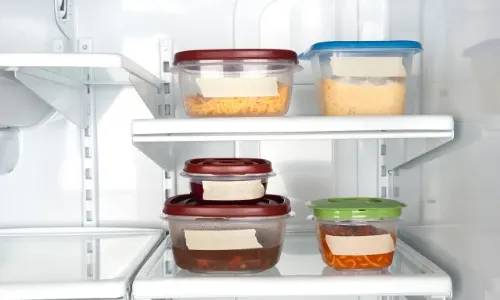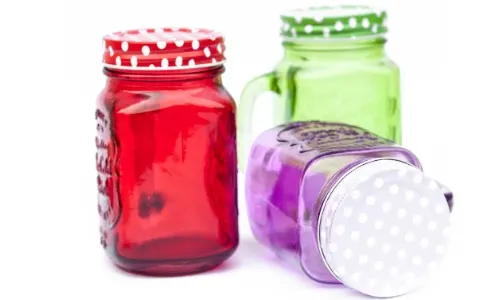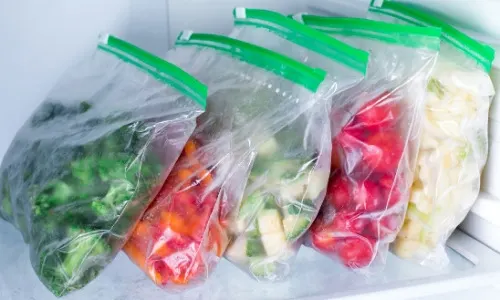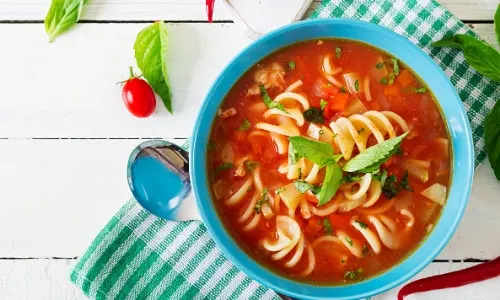We’re often so busy we just can’t get around to doing certain things. In some cases, a frozen meal is our saving grace.
But what if you could freeze your own food, instead of buying it pre-made ?
What if you could freeze soup ? Maybe make a big batch, freeze it into smaller portions and have enough for the whole week.
Well, let’s find out because this sounds like something that could save lots of folks lots of time.
Also please keep in mind that reheating frozen soup is no small task, so be sure to check out our tips on how to do that as well (use the table of contents).

Can you freeze soup ?
Yes, you can freeze soup. Some soups may lose a lot in texture and/or flavor after reheating, but there are workarounds for that and we’ll get to those as well.
For now, know that you can indeed freeze soup and at least by making it at home you know exactly what’s in it, when you made it, and it’s done just the way you like it.
That being said, we should take a look at some common soup types that can be frozen, so you know what to expect and how to properly freeze them.
Believe it or not, there’s a method to this thing and you need to know what you’re doing. So, let’s get into them.
Can you freeze soup with cream or milk ?
Often soups call for some sort of dairy, especially if they’re supposed to come out creamy or decadent.
While you can freeze any soup with dairy, the result after thawing is pretty disappointing. The proteins in dairy will separate from the fats and when and your soup will be grainy.
This also happens when you just refrigerate it, though at a smaller scale. Adding sour cream to a soup will make it nice and creamy-sweet when fresh, but it will turn into little grains overnight.
The main culprit here is the change in temperature. Both freezing and boiling dairy gets it to separate, so maybe add the dairy only after you’re reheated your base soup.

Can you freeze cream soup ?
Cream or blended soups are amazing and they’re pretty much a comfort food, at least for us personally.
If your soup if entirely blended then yes, it’ll freeze pretty good since there isn’t much texture to ruin after thawing.
But if part of it is blended and you also have some big chunks – like creamy potato soup with broccoli bits for example – then those will lose their texture after thawing.
As with dairy, it’s best to add those veggies or chunks after you’re already reheated the base soup.
Read Also:Does Marinara Sauce Have Meat ?
Can you freeze vegetable soup ?
If your soup if just liquid with veggies, like a veggie broth then you’ll lose all texture when thawing. Like with frozen guacamole, the water in veggies will make them extra mushy when reheated.
This is because they’ll form more tiny ice crystals than other foods, which will really break down their structure once thawed.
So we recommend not freezing vegetable soup. Unless you’re okay with removing all vegetables and only freezing the base/broth, but you’re going to have a lot of work when you want to serve a batch.
Can you freeze soup with meat ?
In theory soups with meat are alright to freeze. If it’s something like a chicken soup the meat will be fine but the noodles will lose structure and get grainy.
So again, you may have to separate the base from the veggies, but you can leave the meat in.
If you’ve got big chunks of meat (like a whole chicken drum) know that they’re going to take a long time to reheat, so maybe shred big meats into smaller pieces that heat up better.
Think about dairy and pasta or grains for a second. If your soup has any of those you may want to skip freezing.

How long does soup last in the freezer ?
Alright, now let’s say you’ve decided the soup must be frozen and it’s safe to do so. Okay, how long can you leave it in the freezer ?
Well, like most other things you can keep soup for a long time in the freezer, but it will get a weird taste after a few months.
This is why you should only keep soup in the freezer for up to 3 months, and do you best to not reach that point.
The more you leave the soup frozen, the more flavor your lose.
Always freeze soup fresh
When deciding to freeze soup always freeze a fresh batch.
If you freeze 3 day old soup then it might not come out as good when you thaw it.
Another reason to freeze fresh soup is because fresh means no bacteria or mold has started to develop in your soup just yet, so chances of food poisoning are pretty low.
We’re aware that sometimes you can just forget about a food item in the fridge for several days and then you feel bad about and and maybe don’t want to throw it away.
We’re all about reducing food waste here, but in the interest of your own safety do not freeze old food and reheat it.
Best to just toss it if it’s 4-5 days old, and know better next time you make a batch. Make it smaller and eat it within 3 days, or freeze all of it as soon as it’s cooled down.
What’s the best container to freeze soup in ?
Although it may sound like you can put the whole pot in the freezer, please don’t do that. You need some specific containers that will not impart any flavors and won’t break when freezing.
Here are some of the best examples we’ve found.

Glass containers work best, but are fragile
Glass is neutral and doesn’t give any flavors while your food is frozen, nor when it’s heating.
But, glass is VERY FRAGILE. Sorry for yelling but we really need to get the point across.
If you use glass containers for something that needs to be reheated, you need to be smart about it. You can’t put a frozen jar of soup in the microwave on high and not expect it to crack.
But you can take out the soup the night before and thaw it for several hours on the counter, and only then put it on high in the microwave.
Or better yet heat it on the lowest setting, this way the temp change isn’t sudden.
If you want to be really safe look for tempered glassware. Most glass can’t handle going from frozen to burning hot in a matter of minutes, mainly because glass is fragile and because it’s not flexible.
All liquids contract when they freeze and then expand (quite a bit) when they heat up so don’t fill your glassware to the brim, leave at least an inch on the top.
Resealable freezer bags are good too
Freezer bags are a great way to freeze soup, since they’re easier to find than tempered glass and if you’re patient you can even freeze your soup in flat sheets, so you can stack them in the freezer.

Avoid reheating in the freezer bags though, since they don’t really hold up well and you may be unlucky enough to get a burst bag in the microwave.
The same goes for Tupperware or any plastic storage container, whether it’s a box or bag.
You can freeze the soup in them and also thaw it in the same container, but we recommend you reheat it in the bowl you’re going to eat from – something glass or ceramic.
Tips on reheating frozen soup
When reheating frozen soup you should really be careful. After all this is a block of solid ice and just throwing it in the microwave isn’t going to produce the best results.
Yes, it’s the most convenient way to reheat things but dear God it makes things so mushy if you don’t know what you’re doing.
Not everything comes out nice after being frozen, and barely anything retains its structure after being microwaved.
So here are some crucial tips to understand and apply when reheating frozen soup. To be honest, these apply to many other foods as well.
Let soup chill before freezing
Do not freeze hot foods. You’ll mess with the freezer, and here’s why.
A freezer is meant to keep foods at a certain ambient temperature, usually a minimum of -18 C/ 0 F.
This takes time to do and each time you open the freezer door you raise them ambient temp.
Likewise when you introduce a non-frozen food into the freezer it will raise the temperature and the freezer needs to work harder to bring everything back to -18 C/0 F, and this can take several hours.
Putting something that’s actively warm (or worse, hot) will raise the temperature in the freezer to much it will start to thaw the other foods.
It’ll take even longer to bring everything down to the correct temperature.
So when you decide to freeze your soup make sure it’s at least at room temp, if not lower than that.
This means letting it chill completely before you put it into a container and then in the freezer.

Freeze in single-serve portions
It’s best to freeze soup in single serve portions, this way you won’t reheat a large batch and eat from it for 2-3 days in a row.
It’s also easier to manage if you’re a small family or live alone.
However there are some things you really should keep in mind before you reheat your frozen soup.
Add grains, beans, pasta or veggies only after thawing
Your frozen soup (unless it’s a creamed/blended soup) most likely has some extra pieces in there to give it more texture and flavor. The trouble is that those extra pieces will not hold up after thawing.
It’s the freezing process that ruins them – tiny ice crystals form inside each food item and they wreak havoc on the fibers and general structure of the food.
So items like vegetables (mostly water with a bit of fiber) are going to be mushy and there’s nothing you can do about it, except not add them in the soup.
Add them after thawing the base soup, when you’re reheating and this way the veggies will be fresh and flavorful.
The same goes for beans, grain, and pasta since they will become very grainy due to being broken into millions of tiny ice bits.
Especially pasta, which may contain eggs and those definitely don’t hold up well in the freezer.

Another important point about why you should add these items fresh, only when reheating, is that you retain the texture.
Think about it, frozen solid pieces of veggie or pasta will cook through slower than the broth in your soup. Meaning by the time the pieces are warm enough to eat, you’ll overcook them.
We’re very aware that this step of only adding the ingredients fresh, while reheating, is more work. The main advantage of freezing your soup is to have an easy-access meal at all times.
Unfortunately, this is not the case with many soups. If you care about texture and flavor and don’t want to take extra steps when reheating it, then freezing the soup is not okay for most soups.
Creamed/blended soups that have no dairy, veggies chunks, grains or pasta are okay to freeze and reheat as you will. No fuss there.
Add dairy or nut creams after thawing
Alright, we should discuss dairy a little bit here. The same goes for pretty much all nut milks or creams, so hang on.
The main problem with these foods is that the proteins will end up separating from the fats, and in the case of dairy you may get some whey separation too.
Coconut milk is guilty of this too, and it’s a basic ingredient in curry and curry soups, so be careful.
If your soup is delicious and decadent and happens to have some delicious cheese melted in it, it will be grainy if you freeze and reheat it.
Actually it will start to get grainy the moment it cools down in the fridge, and especially so if you reheat it.

It’s the reheating that’s half the problem, because it’s basically cooking your food all over again. And as we all know, molten cheese should not be actively heated.
Allowed to melt in residual heat, yes.
Actively heated and possibly simmered, definitely not.
The same applies for any dairy, though it’s maybe not as severe as with cheese.
As for nut milks or creams, they too will separate but these can be blended together via immersion mixer.
You just need to remove everything else from your base soup, blend it when hot, and add everything back in.
Blend with immersion blender for creaminess
Yes, the blender that saves the day. Really it’s one of the best thing you can do to a soup that’s lost all texture and bite.
If you’re okay with creamed soup and don’t mind an extra step, then go ahead and blend the whole soup.
Exactly what kind of blender you use is up to you, though immersion blenders are easier to move around.
Keep in mind that if you’ve got chunks of meat in your soup you shouldn’t be blending them (unless you mean to) so remove them before blending, and add them when you’re done.
Reheat on the lowest setting
Melting a block of ice is hard, and you risk unevenly cooked soup on the highest setting.
That’s pretty much the basics of microwaving frozen soup. We keep going on and on about this because we know most folks won’t have the patience to melt that soup in an oven or thaw it overnight on the counter.
So microwave it is, and you should be using your lowest setting. If it has a defrost setting, use that.

Yes, this does take longer but your soup will be evenly thawed and you won’t have overcooked bits mixed in with frozen bits (especially in the middle).
You can use the defrost first and then use a higher setting to bring it up to your preferred temperature, but don’t use the highest possible setting.
We know it sounds tempting and it sounds like it could be fast. But the result is always uneven, so use the middle/medium setting for best results.
Also know that some thick soups may just pop and burst every now and then and make a mess in the microwave, so be sure to use a cover.
Read Also:Here’s How Long Mashed Potatoes Last In The Fridge
Avoid reheating in plastic containers
Plastic containers is what you’re probably using, and that’s understandable.
They’re easy to use, easy to clean and they stack perfectly in the freezer.
But they’re pretty bad at being microwaved, even the ones that say they’re microwave safe.
We’re not talking about BPA here, though that’s also a concern. We’re talking about how warped the containers get.
Freezing food in them is alright, as long as they’re thicker material and as long as you don’t reheat the food directly in them. Easy to clean.
If you heat food in them you risk warping the plastic too much and getting those horrible food spots on the sides, you know the ones.
And why should you avoid those spots ? Well if you’ve got something with tomato paste you’ll notice those red-orange stains never go away completely.
That’s pretty much a visual representation of how long-lasting bacteria can be in those spots, and we don’t want to risk that.
Not to mention another thing we’ve noticed: reheating in a plastic container makes the fats and oils stick to it like crazy.
A dishwasher WILL NOT be able to clean it well. All it can do is mess with the other dishes by dripping oily water on the clean ones.
Really, those containers need to be washed, nay scrubbed by hand and you need to do a very good job.
Conclusion
Alright, this was a lot to take in but hopefully you know just what to do with frozen soup.
To be honest we recommend you try your best to not have to freeze the soup, since it will never be as food as when it was fresh.
But if you’re in the position where you need to freeze it we hope this article gave you a very thorough guide and some great tips.

